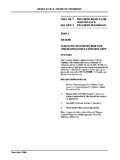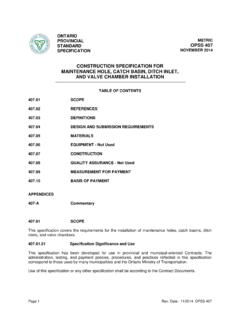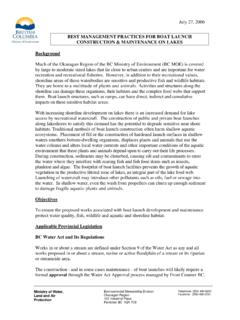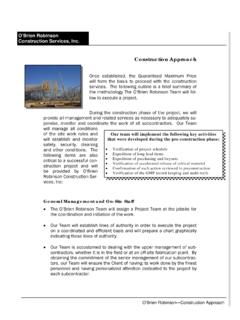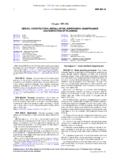Transcription of Manual for Transmission Lines and Substation Construction ...
1 Manual for Transmission Lines and Substation Construction and maintenance Activities Volume I Best Management Practices Volume II Permits Prepared for Prepared by HDR Engineering, Inc 701 Xenia Avenue South, Suite 600 Minneapolis, Minnesota 55416 February 2007 Table of Contents BMP Manual i February 2007 FINAL Table of Contents IV VOLUME 1-1 BEST MANAGEMENT 1-1 1-2 1-2 Plan and 1-2 Cultural 1-3 Site 1-3 Construction 1-4 Access 1-4 1-5 1-5 EROSION 1-7 Preservation of Existing 1-8 Topsoil 1-10 Mulch, Blankets, and 1-10 Slope 1-13 Directional Tracking and 1-15 Soil 1-15 Streambank 1-15 SEDIMENT 1-17 Silt 1-17 Silt 1-17 Sediment 1-20 Sediment 1-20 Fiber 1-21 Check 1-21 Inlet 1-23 Street 1-23 Vegetative 1-23 Construction Entrance and 1-26 Dust 1-26 VEGETATIVE 1-28 1-29 1-35 Table of Contents BMP Manual ii February 2007 FINAL 1-37 1-45 1-49 Local Seed 1-49 STORMWATER 1-51 Infiltration 1-51 Constructed 1-51 Retention and Detention Pond 1-51 GENERAL 1-52 Residential 1-52 Highway and Road Crossings.
2 1-52 Wetland 1-53 Stream and River 1-57 Trout 1-61 POLLUTION PREVENTION MANAGEMENT 1-62 Spill 1-62 Trash and 1-65 Hazardous 1-65 GENERAL 1-66 1-66 1-68 Record Keeping and 1-68 List of Tables Table 1 Erosion Fabric Categories .. 1-12 Table 2 Slope Breaker 1-13 Table 3 Illinois Permanent Seeding 1-32 Table 4 Iowa Temporary Seed 1-35 Table 5 Iowa Permanent Seed 1-37 Table 6 Minnesota Temporary Seed 1-40 Table 7 Minnesota Mixture 1-40 Table 8 Minnesota Permanent Seed 1-44 Table 9 Minnesota General Fertilizer 1-45 Table 10 Wisconsin Temporary Seeding 1-46 Table 11 Wisconsin Permanent Seed 1-47 Table 12 After Construction BMP maintenance Activity and 1-66 Table of Contents BMP Manual iii February 2007 FINAL List of Figures Figure 1 Dairyland Power Cooperative Service v Figure 2 Slope Breaker 1-14 Figure 3 Illinois Soils 1-31 Figure 4 Iowa Soils 1-36 Figure 5 Minnesota Soils 1-39 Figure 6 Wisconsin Soils 1-48 Detail Sheets Detail Sheet 1 Access Road Typical 1-6 Detail Sheet 2 Preservation of Existing 1-9 Detail Sheet 3
3 Silt 1-18 Detail Sheet 4 Silt 1-19 Detail Sheet 5 Fiber 1-22 Detail Sheet 6 Inlet Protection Type 1-24 Detail Sheet 7 Inlet Protection Type 1-25 Detail Sheet 8 Construction Entrance and 1-27 Introduction BMP Manual iv February 2007 FINAL Erosion and sediment control measures apply to all earth moving activities small or largeIINNTTRROODDUUCCTTIIOONN Dairyland Power Cooperative (Dairyland) is a generation and Transmission cooperative based in La Crosse, Wisconsin that provides wholesale electrical energy to 25 member cooperatives and 20 municipalities who deliver the energy needs to over 500,000 Dairyland s service area comprises 62 counties in Illinois, Iowa, Minnesota, and Wisconsin (Figure 1). Dairyland owns and operates over 3,000 miles of Transmission line, over 200 distribution and Transmission substations, numerous communication sites, and generation and utility properties.
4 Dairyland is committed to the preservation and protection of precious natural resources. This best management practice (BMP) Manual and field guide were created in acknowledgement of that commitment. This Manual will provide Dairyland staff, consultants, and contractors with a comprehensive source for BMPs related to earth disturbing activities during Construction , repair, and maintenance work associated with Transmission Lines , substations, and other cooperative projects. The associated field guide is a water-proofed version of this Manual , which summarizes key erosion and sediment control points for use by field crews. Federal and state environmental permit information was also included in this document for reference. These practices and procedures, when properly implemented, will minimize or prevent erosion and sediment pollution from adversely affecting sensitive resources, such as, streams, ponds, lakes, wetlands, and natural vegetative.
5 Erosion and sediment control measures are generally recognized as a necessary component of large Construction projects. It is equally important to note that those same measures apply to all earthmoving activity, regardless of size or scope. The smallest Transmission line repair activity could change water temperature in nearby trout streams or transport noxious weeds across property Lines if crucial BMPs are not applied where required. BMPs are, in fact, required in some form for all activities to preserve sensitive resources, regardless of the project size. This BMP Manual provides a comprehensive reference source for BMPs for Construction activities and environmental compliance/permit policies and procedures. This Manual must be periodically updated to reflect changes in BMPs in regulatory policy and in enforcement trends affecting and/or influencing the activities of Dairyland.
6 1 McWilliams, John M, MBA, PE. Dairyland Power Cooperatives Methane Digester Project, AgSTAR National Conference. Madison, Wisconsin, 2006. Map Document: (N:\gisproj\DPC\41569\map_docs\mxd\SOILS \ )10/25/2006 -- 1:52:10 PMFigure 1 Dairyland Power CooperativeService AreaMinnesotaWisconsinIowaIllinoisFLegen dIllinoisIowaMinnesotaWisconsin Introduction BMP Manual vi February 2007 FINAL All individuals working on Construction projects are responsible for complying with permit requirements and the associated BMPs as designed and detailed in this Manual and further specified by the Project Manager within site plans. If questions arise concerning environmental requirements, the Project Manager should interpret compliance requirements. If the Project Manager is not available or able to resolve an issue, Dairyland s Manager, Siting and Regulatory Affairs should be notified.
7 Some Construction projects may require additional local environmental permits that could contain additional requirements that may be more restrictive than those identified in this Manual . Compliance with local permit requirements is mandatory. This Manual is presented in two volumes. Volume I contains BMPs necessary to protect sensitive resources from erosion and sediment transport in stormwater runoff when constructing Transmission Lines , access roads, substations, other utility-related improvements, or when conducting maintenance operations in or around sensitive resources. Volume II contains a comprehensive list of federal and state permits required for Construction and maintenance activities. Best Management Practice BMP Manual 1-1 February 2007 FINAL VOLUME I Best Management Practices are actions taken to prevent or reduce detrimental impacts to the environment while maintaining the natural characteristics of the environment.
8 BBEESSTT MMAANNAAGGEEMMEENNTT PPRRAACCTTIICCEE Best management practices (BMPs) are structural, nonstructural, and managerial techniques recognized as the most effective and practical means to control non-point source pollutants, yet are compatible with the productive use of the resource to which they are applied2. For the purpose of this Manual , BMPs presented here are specific to controlling erosion and preventing the transport of sediment-laden stormwater off Construction and maintenance sites. This volume contains the following sections: Planning Construction Activities Erosion Control Sediment Control Vegetative Stabilization Stormwater Treatment General Operations 1. Residential Areas 2. Highway and Road Crossings 3. Wetland Crossings 4. Stream Crossings Pollution Prevention Management Measures General Provisions 2 National Safety Council.
9 Environmental Health Center Glossary. 2005. Retrieved July 7, 2006. Best Management Practice BMP Manual 1-2 February 2007 FINAL Anticipating problems will allow you to plan for these factors and make them easier to deal with. PPLLAANNNNIINNGG Planning for the cooperative s Construction and maintenance -related activities is a crucial part of the successful execution of projects. This step forces the Project Manager to think through factors linked to protecting sensitive resources, such as BMPs, scheduling, right-of-way (ROW) plan and profile, cultural resources, site preparation, and project-related permits.
10 The significance of scheduling, development of site plan and profile, identification of cultural resources, and site preparation are discussed in detail below. BMPs and project-related permits will be addressed in later sections of this Manual . SScchheedduulliinngg The purpose of a schedule of Construction or maintenance activities is to reduce potential impacts to sensitive resources. The schedule serves as a means to incorporate all activities related to a given project. The following steps are useful when completing a Construction schedule3: 1. Outline all land disturbing activities. 2. List BMPs needed to contain sediment and reduce erosion. 3. List required permits, agency review period, and requirements. 4. Combine the outline and lists in a logical order to set up an effective schedule.
